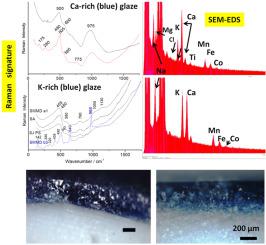Ceramics International ( IF 5.1 ) Pub Date : 2021-09-27 , DOI: 10.1016/j.ceramint.2021.09.246 Philippe Colomban 1 , Anh-Tu Ngo 1 , Howell G.M. Edwards 2 , Linda C. Prinsloo 3 , L. Valérie Esterhuizen 4

|
Shards of Blue-and-White Ming porcelain from shipwrecks of Portuguese ships found on the coasts of South Africa plus a shard from Mombasa (Kenya) were analyzed by optical microscopy, SEM-EDS and Raman microspectroscopy (458 nm). Whereas the Raman signature of porcelain body paste compositions which are based on mullite, quartz and an amorphous phase with the minor presence of anatase and feldspar are very comparable whatever the variable alumina content, at least two types of glazes are observed: a high-temperature soda-potassium glaze, and glazes richer in calcium and similar to a celadon glaze (with the possibility of wollastonite formation). The blue decoration is obtained with a material rich in manganese typical of the Ming productions. Some shards exhibit a two-layer glaze and the blue decoration is either placed under-glaze, or in-glaze as found in the Vietnamese productions of the same period. Previous assignments of the Raman signature of feldspar to cobalt aluminate are now not favoured (blue colour is obtained with Co2+ ions dissolved in the glassy silicate) and several black spots exhibit the characteristic spectrum of an epsilon Fe2O3 phase being present.
中文翻译:

青花明瓷不同上釉工艺的拉曼鉴定
通过光学显微镜、SEM-EDS 和拉曼显微光谱 (458 nm) 分析了在南非海岸发现的葡萄牙船只沉船中的明代青花瓷碎片和来自蒙巴萨(肯尼亚)的碎片。尽管基于莫来石、石英和少量锐钛矿和长石存在的无定形相的瓷体糊组合物的拉曼特征无论氧化铝含量如何变化都非常相似,但至少观察到两种类型的釉:高温苏打钾釉,以及富含钙且类似于青瓷釉的釉(有可能形成硅灰石)。蓝色装饰是用富含锰的材料制成的,这是明代产品的典型代表。一些碎片展示了两层釉,蓝色装饰要么放置在釉下,或在同一时期的越南产品中发现的釉中。以前将长石的拉曼特征分配给铝酸钴现在不受欢迎(蓝色是用 Co 获得的2+离子溶解在玻璃状硅酸盐中)和几个黑点显示存在 epsilon Fe 2 O 3相的特征光谱。











































 京公网安备 11010802027423号
京公网安备 11010802027423号